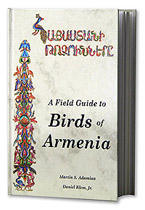- Pictures of All Birds
- Find Bird by Common Name
- Find Bird by Scientific Name
- Find Bird by Armenian Name
- Orders of Birds
- Distribution Maps
- Location of Armenia
- Species of Special Concern

Purchase the Field Guide
© Copyright Birds
of Armenia Project

Orders of the Birds of ArmeniaWorldwide, there are approximately 9,700 species of birds. To better understand and organize their diversity, scientists assign them to 29 orders based on shared characteristics. Because some orders also contain species with widely varying forms, the orders are further subdivided into 187 families based on their likenesses. Of these, there are 349 species belonging to 18 orders and 58 families that have been recorded or are suspected to occur in Armenia. A summary of the distinguishing characteristics of each representative order follows. The number of Armenian species in each order appears in parentheses after the ordinal name. A complete species checklist of the birds of Armenia is available in the Field Guide, available for purchase here. Gaviiformes (2). Loons. Large (L: 53-73 cm) fish-eating, diving birds with long pointed bills and long bodies with webbed feet placed far back. Podicipediformes (5). Grebes. Medium (L: 25-51 cm) diving birds with small heads, short bills, long necks, and round bodies with lobed feet placed far back. Pelecaniformes (4). Cormorants, pelicans. Medium to large (L: 45-180 cm) water birds with all four toes webbed, and most species having a gular (throat) pouch. Ciconiiformes (13). Bitterns, egrets, herons, ibis, spoonbill, storks. Medium to large (L: 33-115 cm), long-necked, long-legged, wading or open-field birds that are often colonial nesters. Phoenicopteriformes (1). Flamingo. Large (L: 125-145 cm) long-necked, long-legged wading birds with a specialized decurved filter-feeding bill. Falconiformes (35). Buzzards, honey-buzzard, eagles, falcons, harriers, hawks, kites, vultures, osprey. Small to large (L: 25-115 cm) diurnal birds of prey with hooked bills, cere (fleshy area around nostrils), and sharp curved talons (claws). Anseriformes (28). Ducks, geese, swans. Medium to large (L: 34-160 cm) water birds with three webbed and one (hind) elevated toe, and flattened bill. Galliformes (7). Grouse, partridges, pheasant, quail, snowcock. Small to large (L: 16-89 cm) land birds with relatively short rounded wings, and strong legs with four toes. Gruiformes (13). Bustards, crakes, cranes, coot, moorhen, swamphen, rail. Small to large (L: 17-120 cm) diverse group of land and water birds with strong legs, and toes not webbed, slightly webbed, or lobed. Charadriiformes (62). Avocet, curlew, gulls, jaegers, lapwings, oystercatcher, phalaropes, plovers, pratincoles, ruff, sandpipers, snipes, stilt, terns, woodcock, etc. Small to large (L: 12-67 cm) diverse water birds that share several internal skeletal traits. Columbiformes (8). Doves, pigeon, sandgrouse. Small to large (L: 25-42 cm) land birds with small heads, fleshy cere at base of bill, round bodies, and short wings. Cuculiformes (2). Cuckoos. Medium (L: 32-40 cm) land birds with long tails, strong feet, and are brood parasites (laying their eggs in other species’ nests). Strigiformes (7). Owls. Small to large (L: 19-75 cm) nocturnal birds of prey with large round heads, big eyes, and strong feet with sharp talons. Caprimulgiformes (1). Nightjar. Medium (L: 26-28 cm) nocturnal or twilight (dawn and dusk) land bird with large mouth and prominent long bristles for capturing insects. Apodiformes (2). Swifts. Small (L: 16- 22 cm) agile fliers with stiff wings and tail, and small feet. Coraciiformes (5). Bee-eaters, hoopoe, kingfisher, roller. Small to medium (L: 16-32 cm) land and water birds with round bodies, large bills, and small feet. Piciformes (8). Woodpeckers, wryneck. Small to large (L: 14-57 cm) land birds with strong bills, tails, and feet used for climbing and drilling in wood. Passeriformes (146). Perching birds. Small to large (L: 9-64 cm) land birds with flexible feet for grasping, and typically having well developed species-specific vocalizations. |